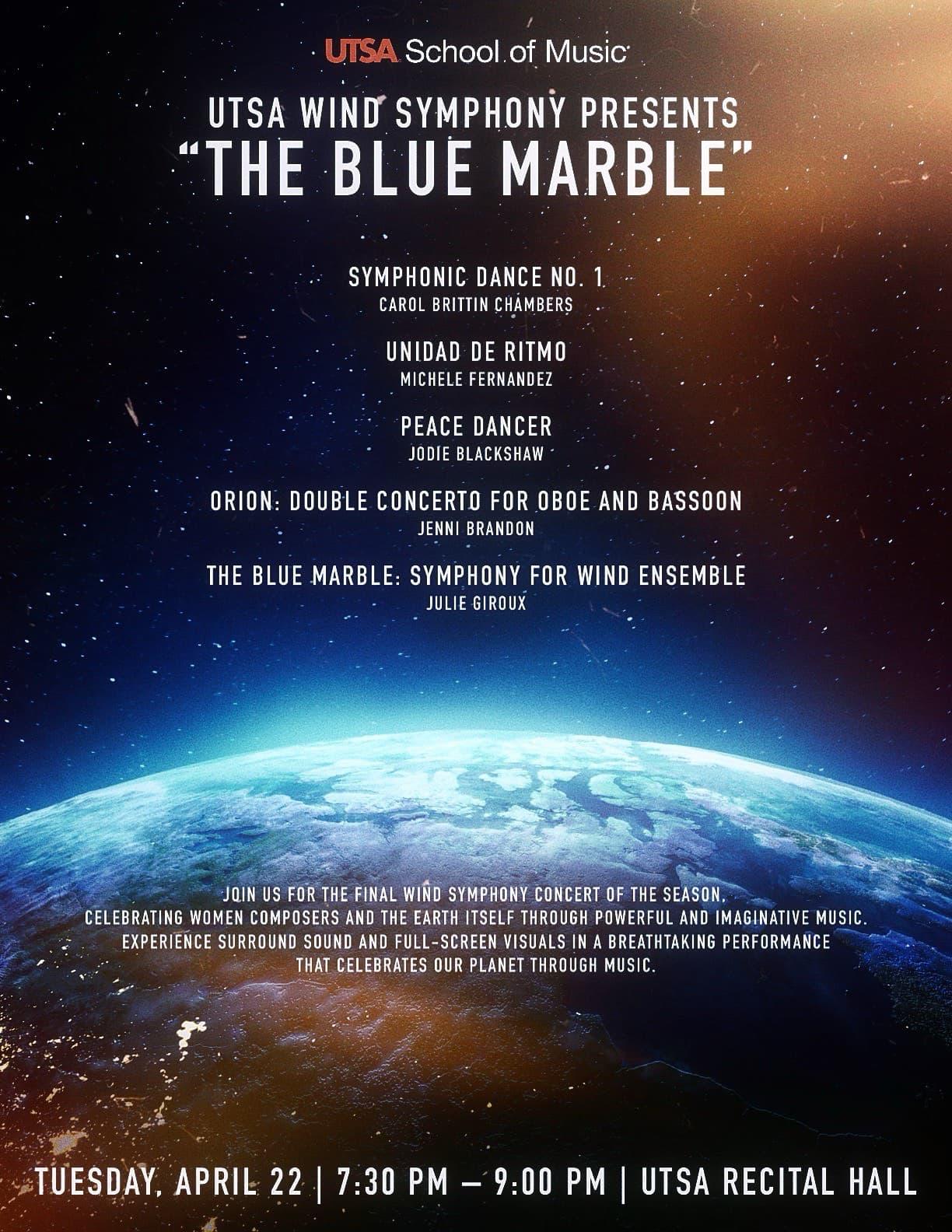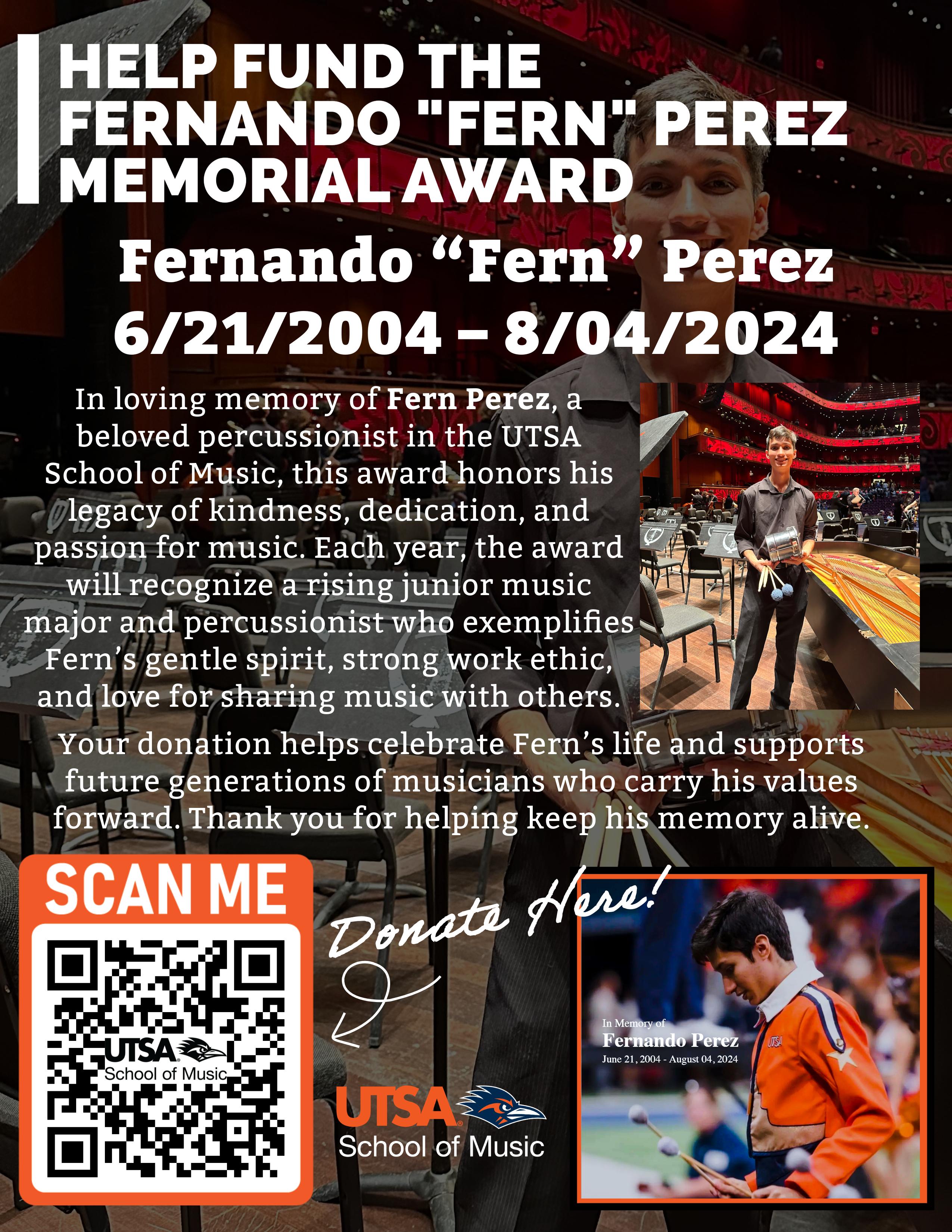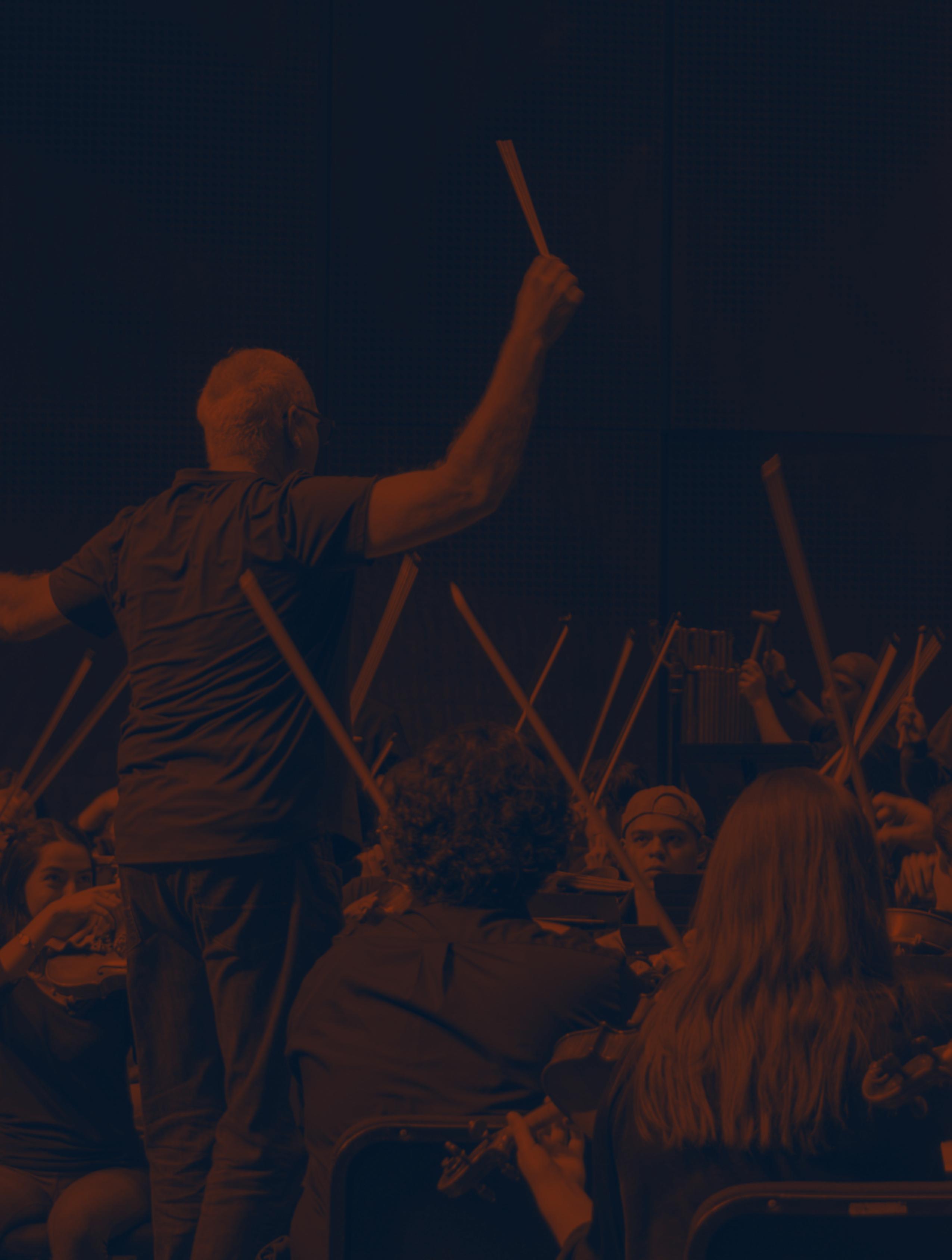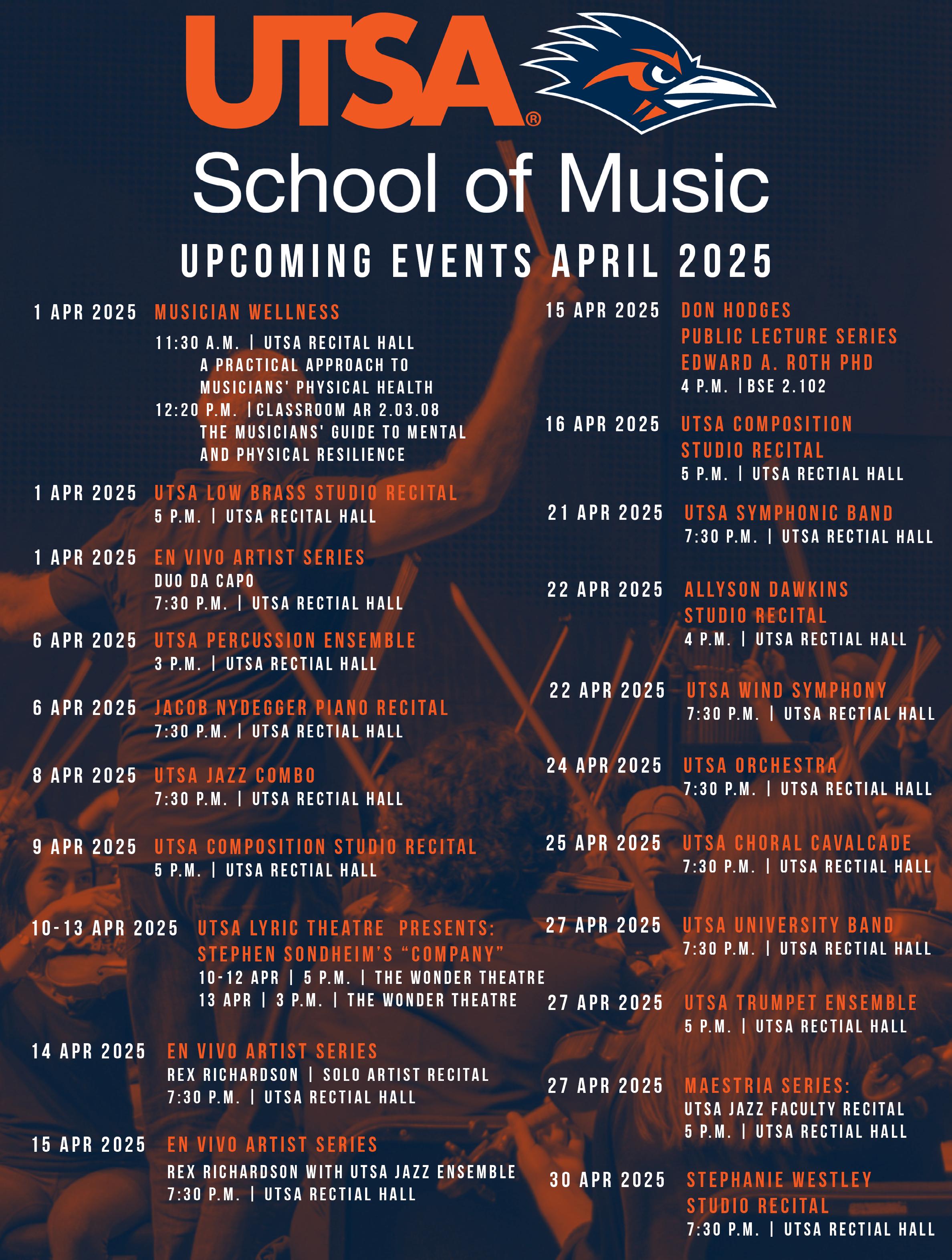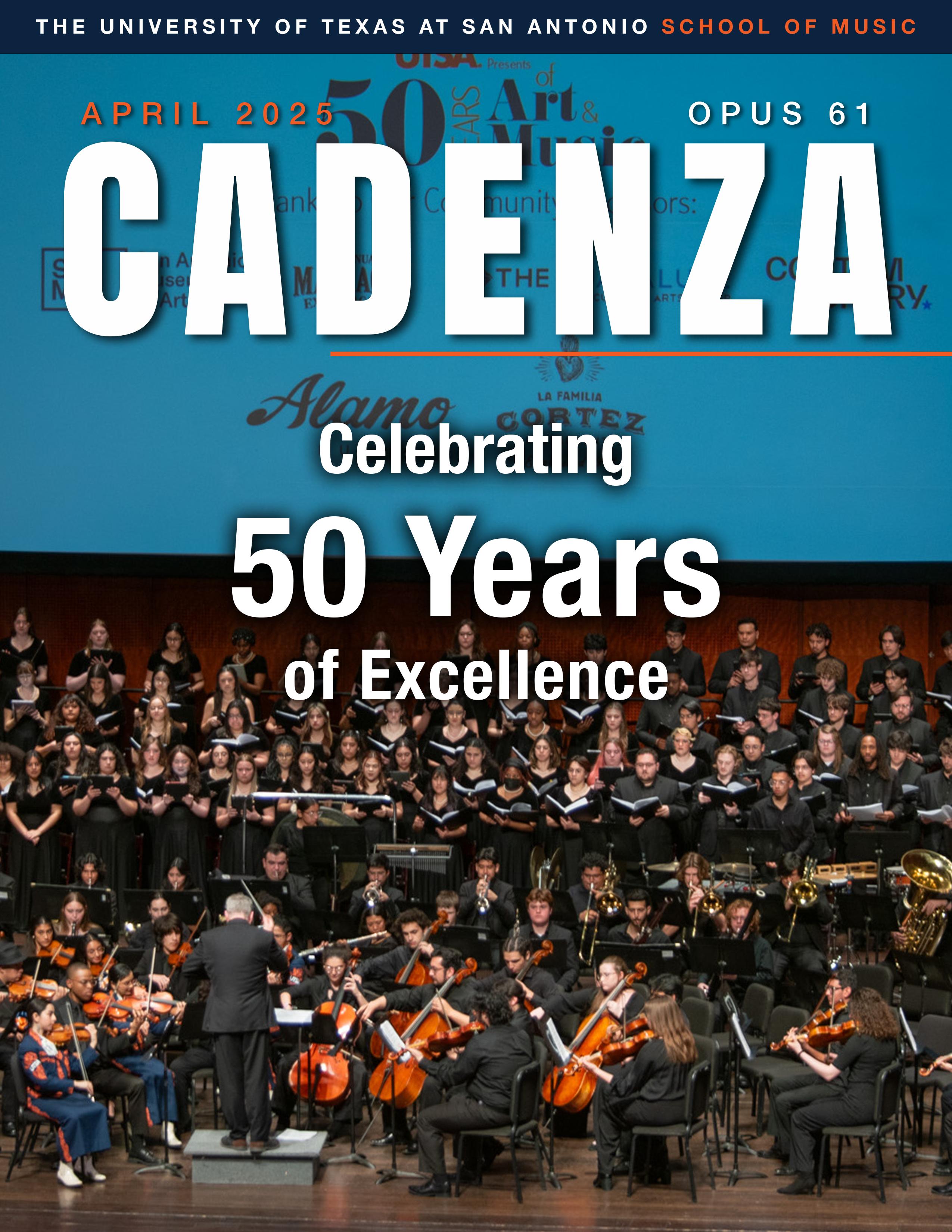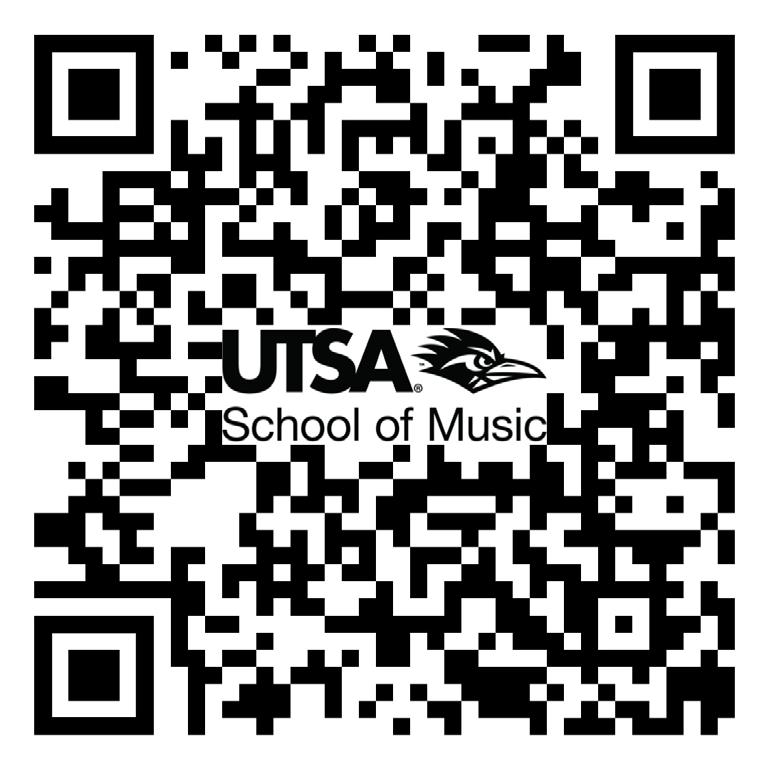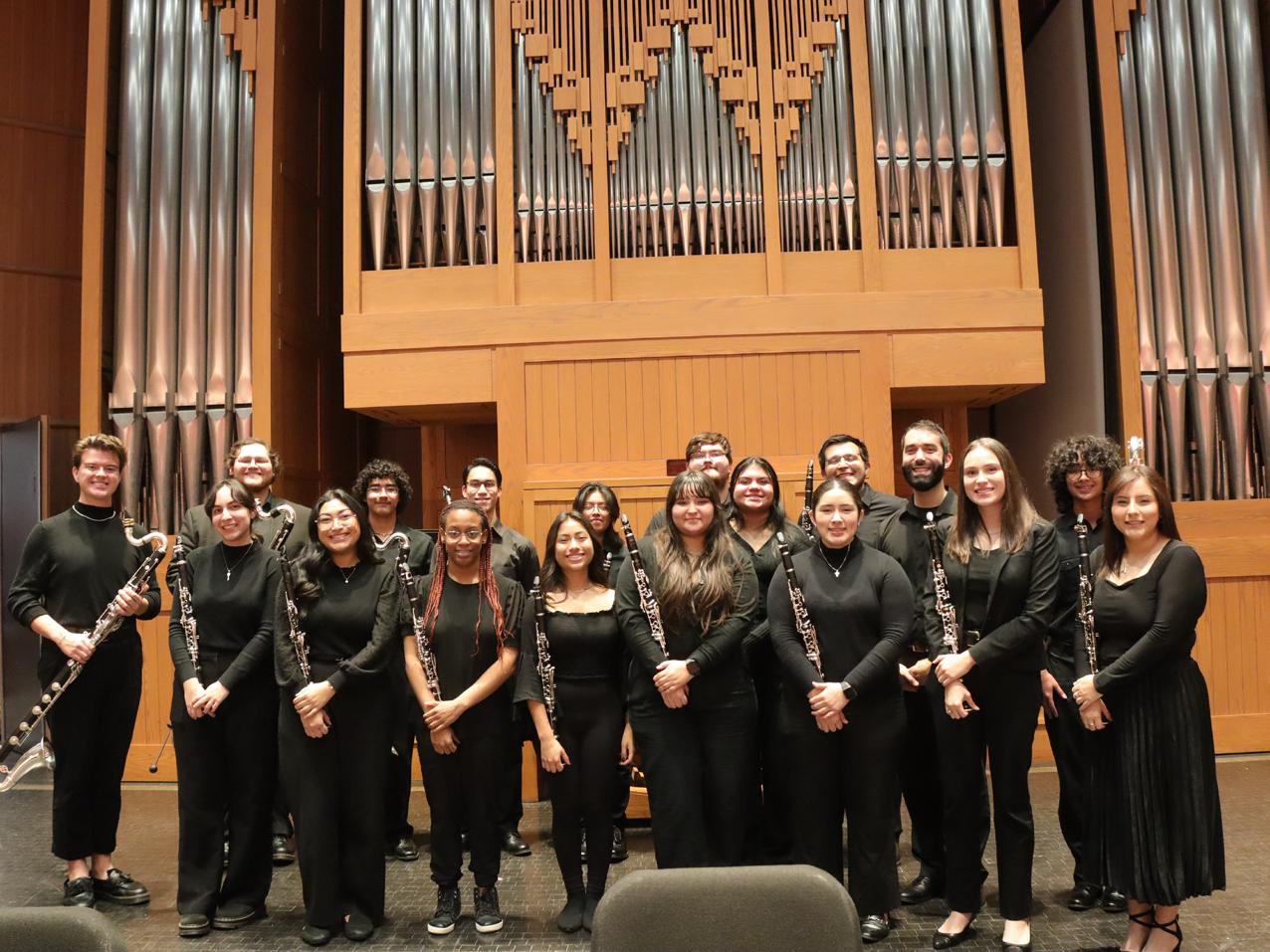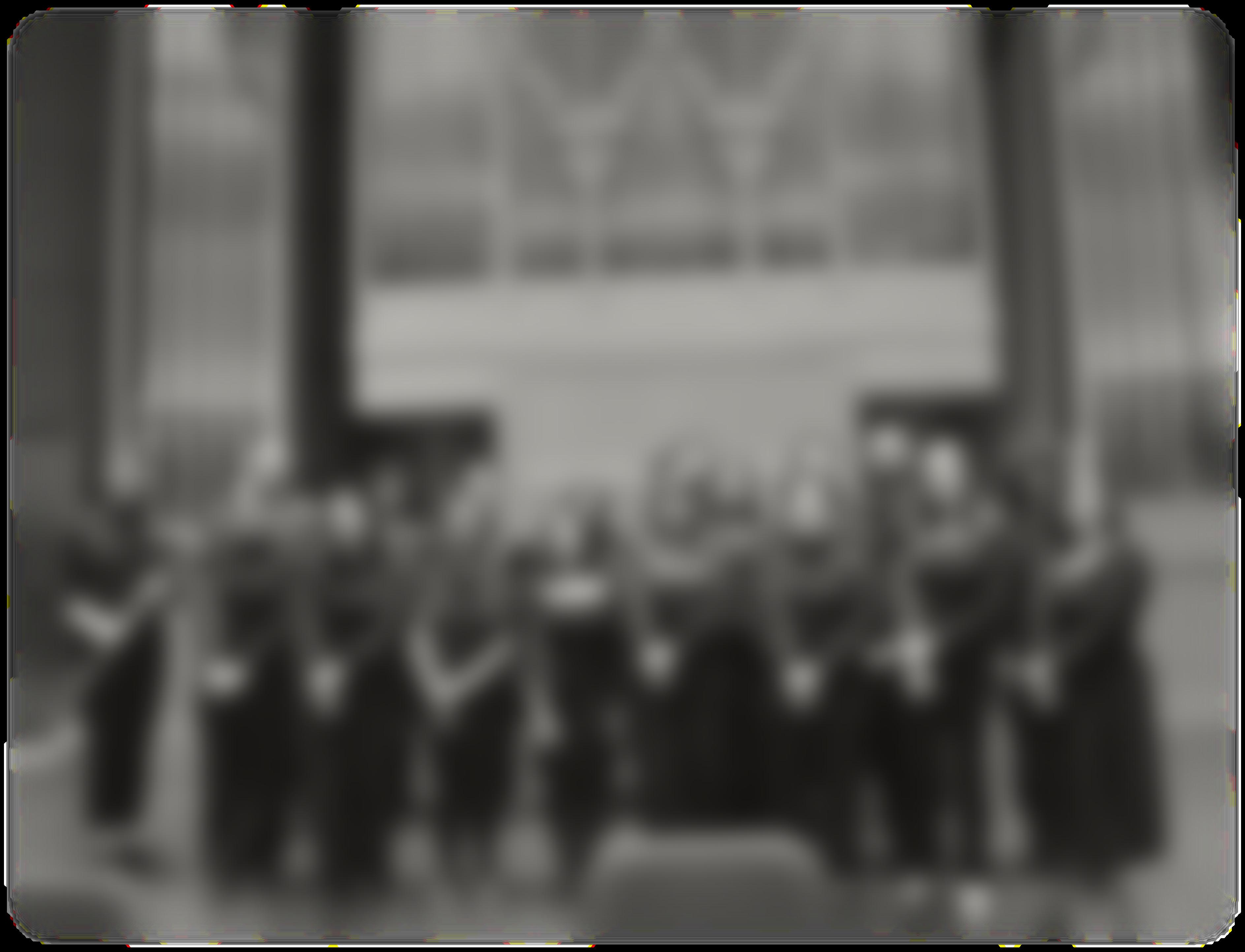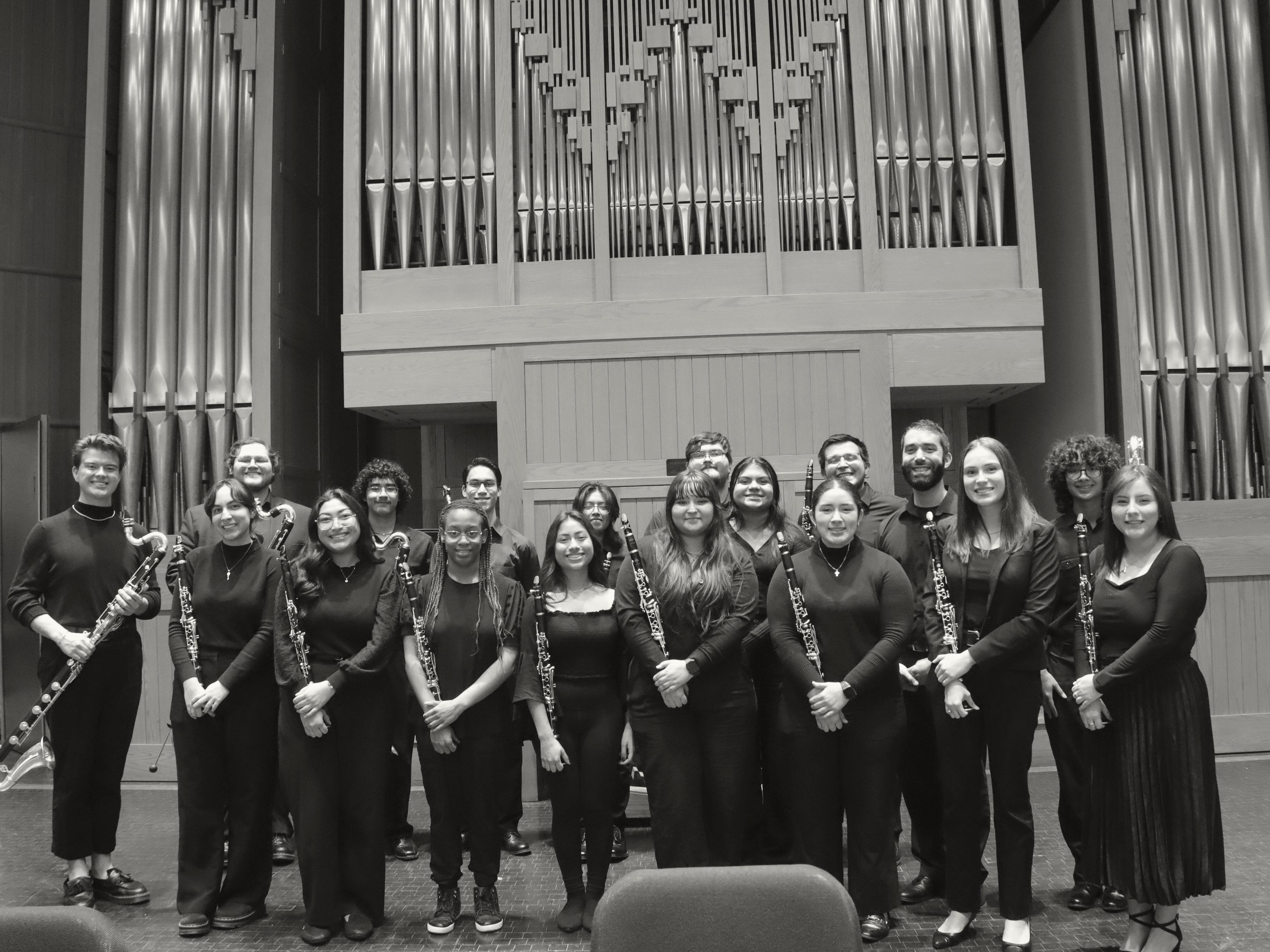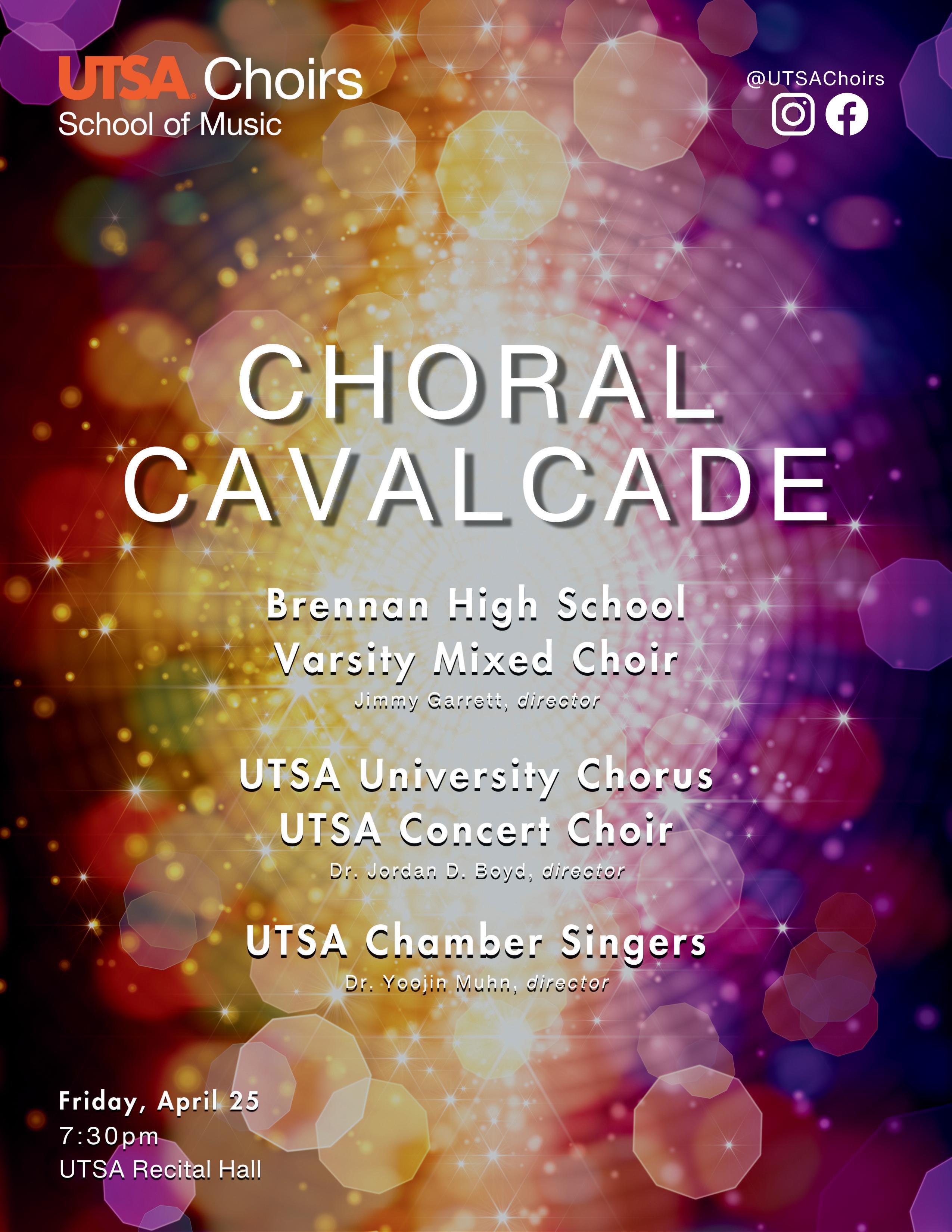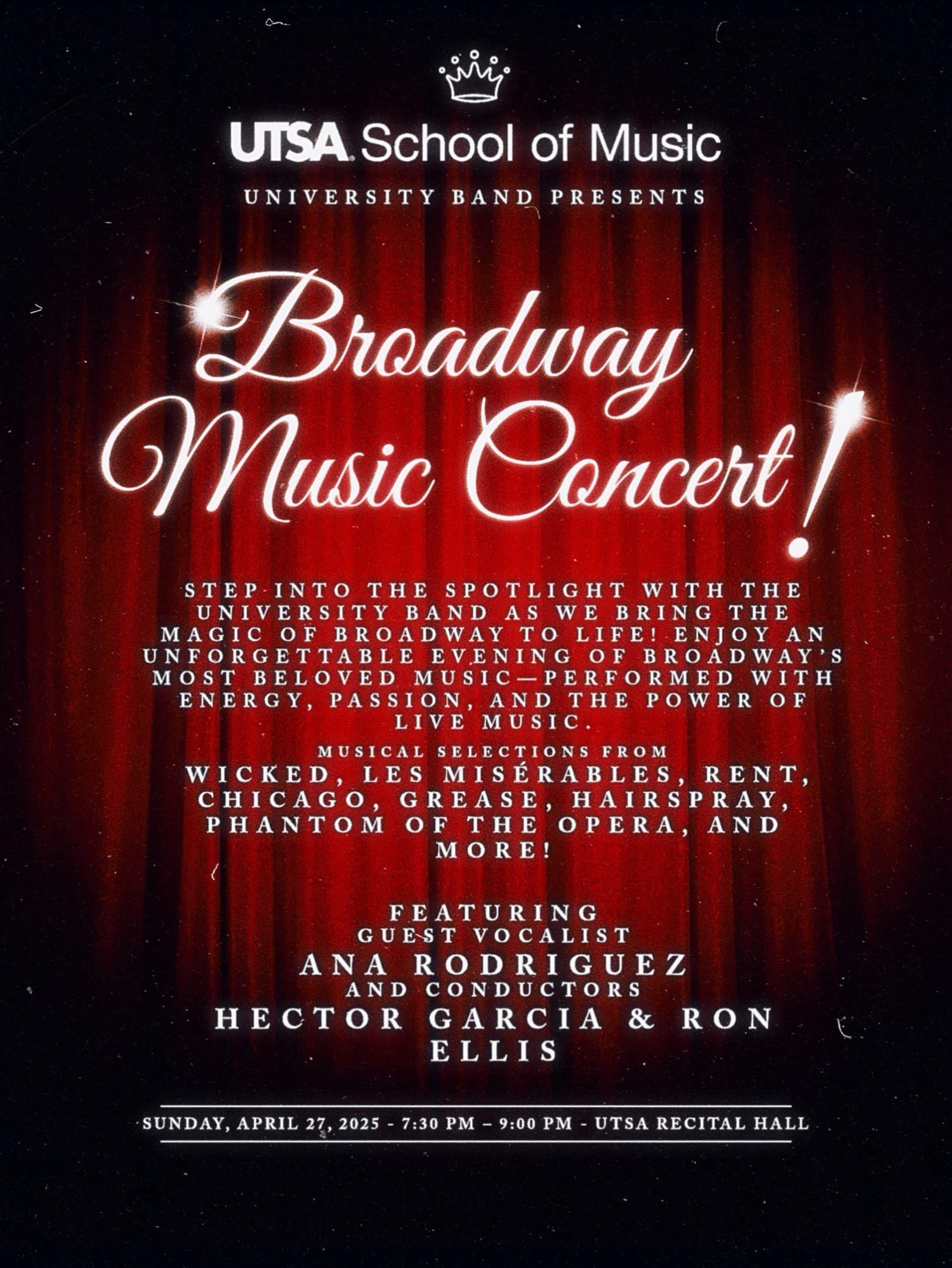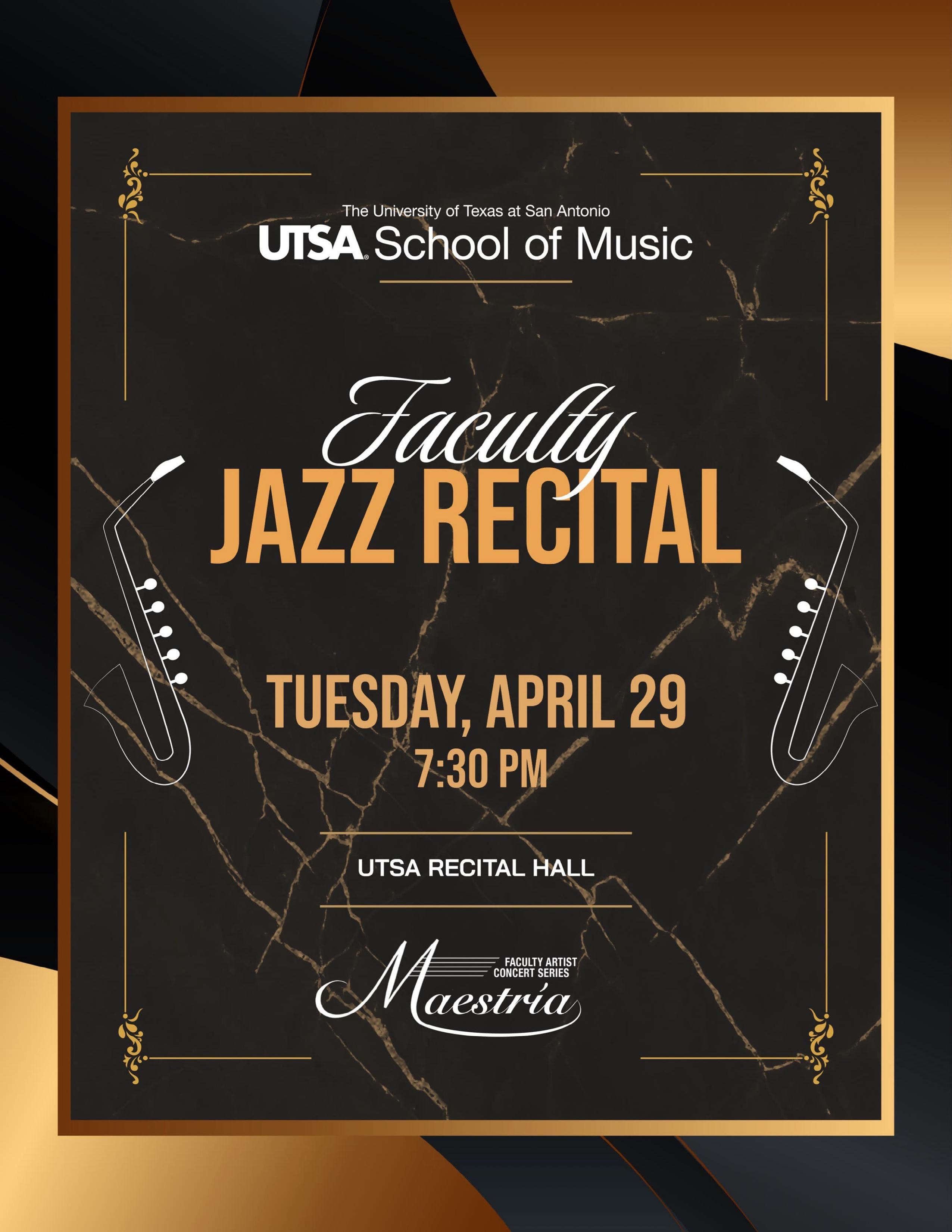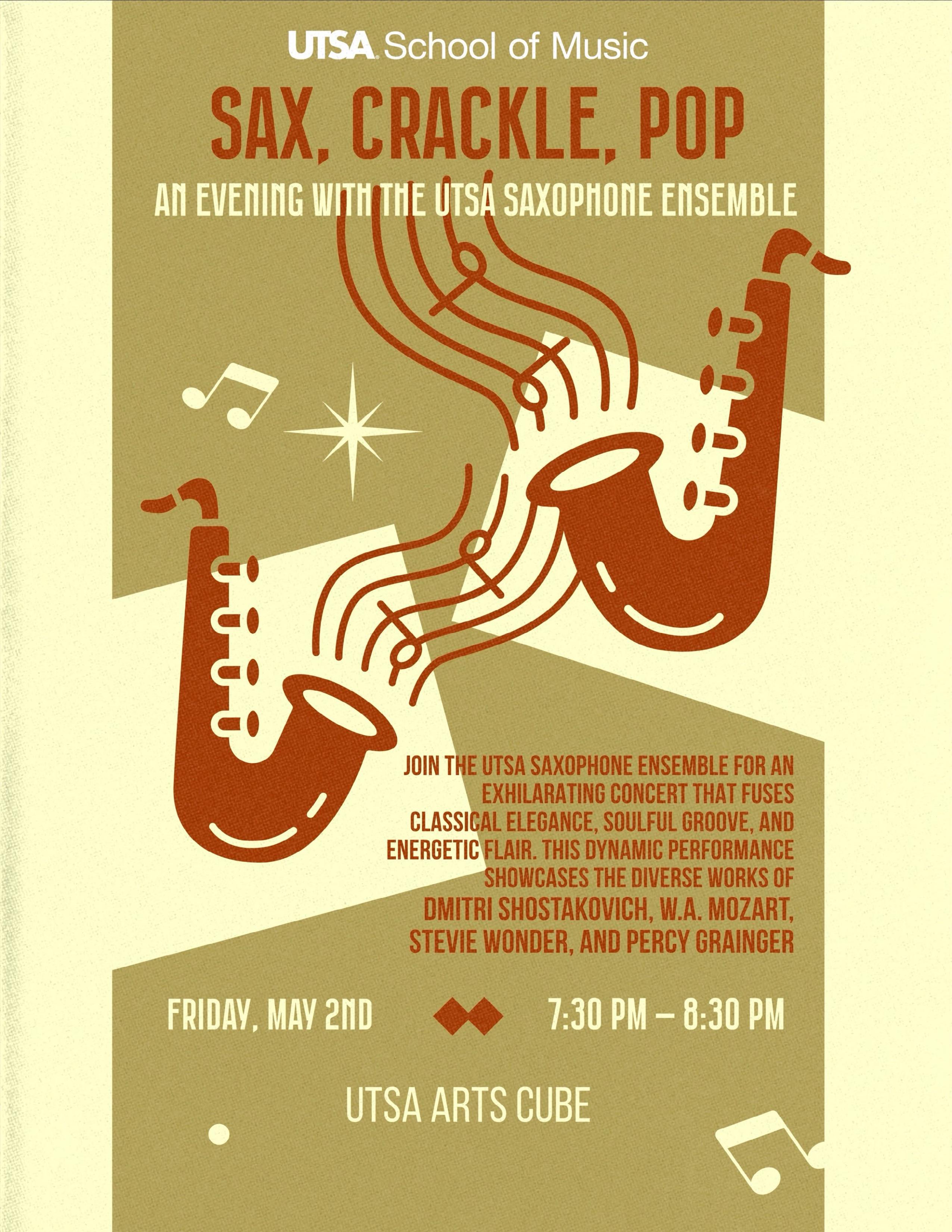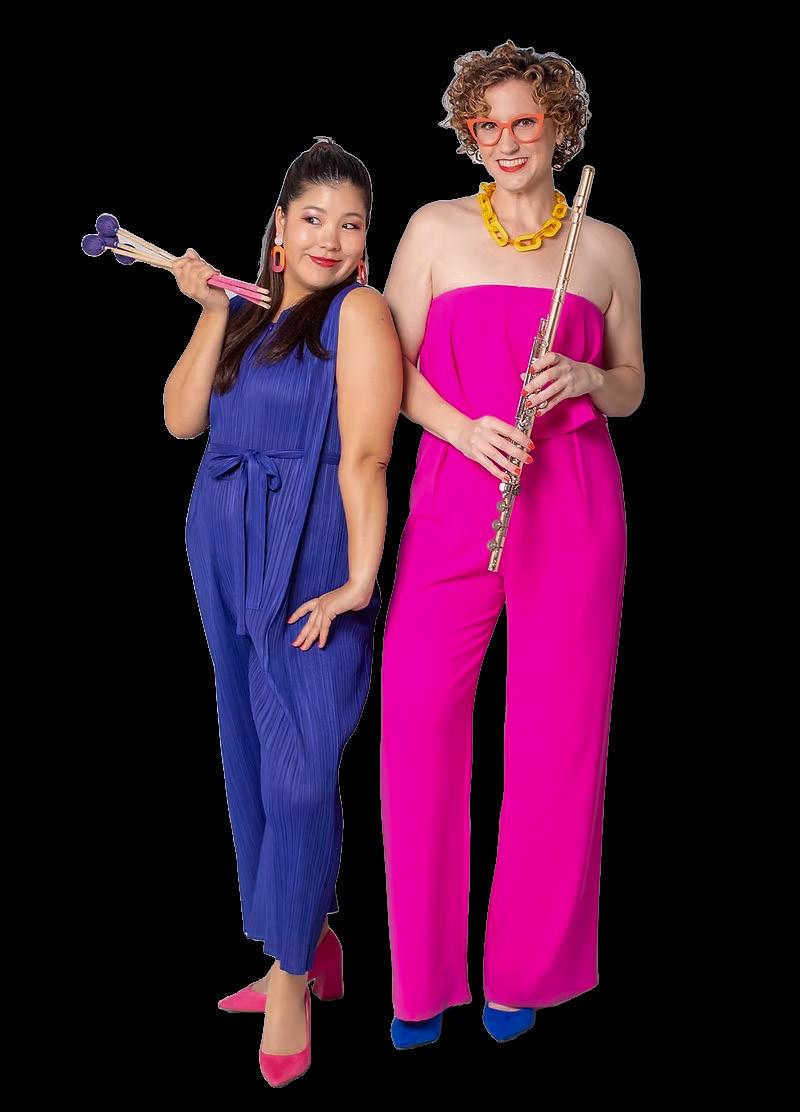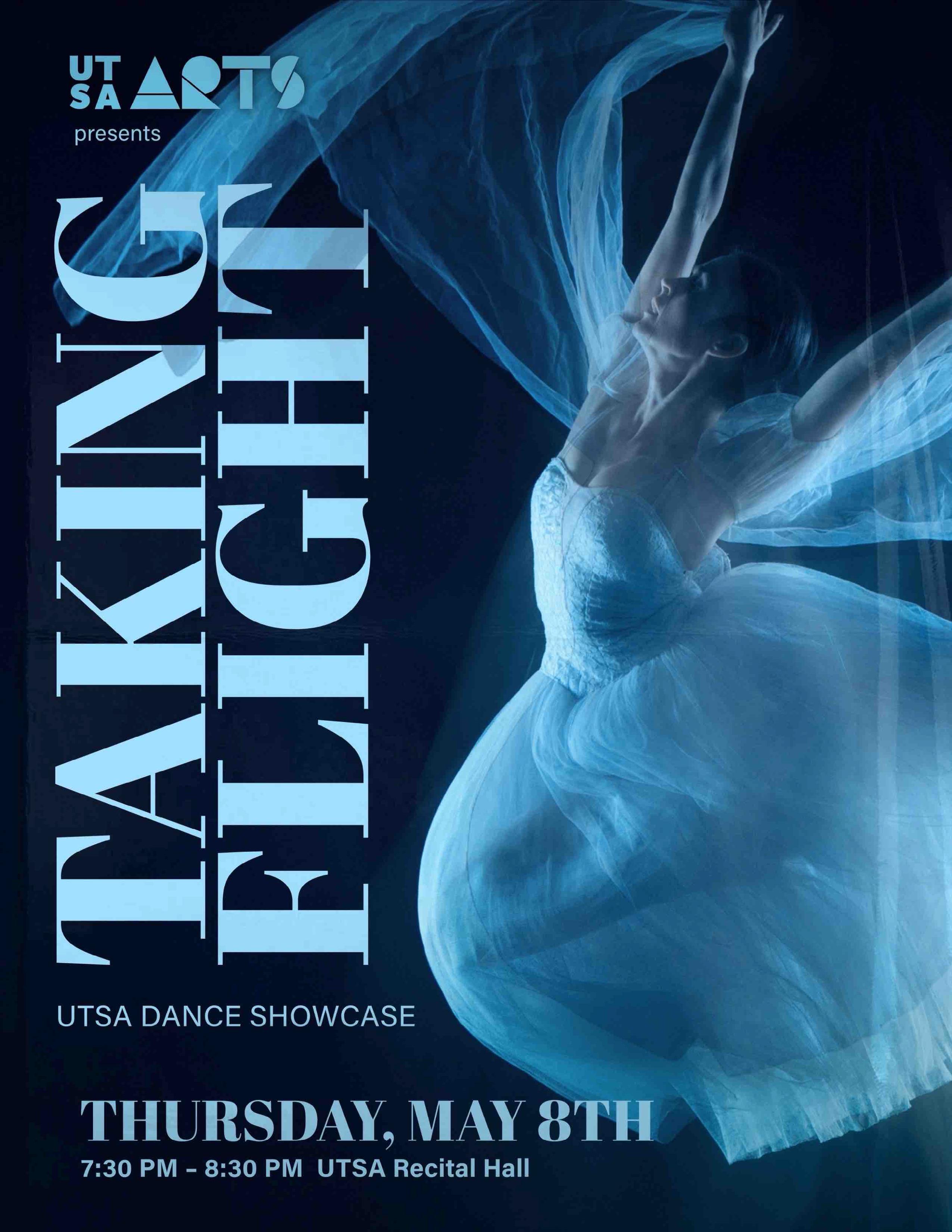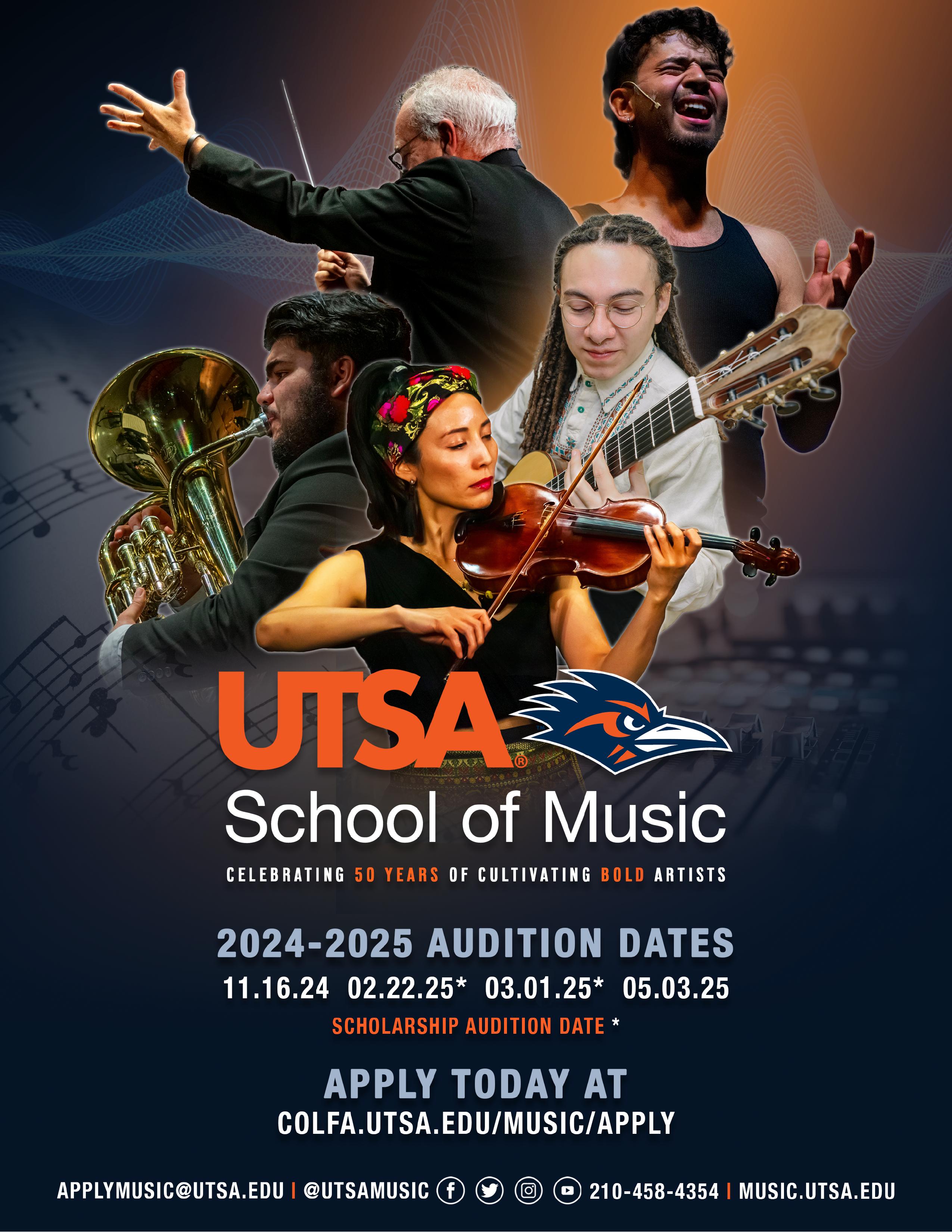Spring 2025 University of Texas at San Antonio Wind Symphony
Fl ute / Piccolo
Joaquin Carcamo
Jazmine Dearlove
Lauren Garcia
Ana Jaud (G)
Amy Leonard
Oboe
Samuel Coleman
Logan Odom
Bassoon
Jaime Viejo
Jared Worman (also Contra Bassoon)
Cl ari net
Sikander Ahmed
Sophie Anderson
Orlando Baron
Kali Crist
Sarah Hamm
Kenedy Lerma
Isabella Miranda
Bass Cl ari net
Michael Lee Summers
Al to Saxophone
1 Gabriel Campa
2 Bryson Vincent
Tenor Saxophone
Parker Murray
Bari tone Saxophone
Brianna Castilla
Horn
Brandon Bayer
James Gonzales
Caleb Jones
Andrew Ramirez
Myrna Ramirez
Band Staff
Jarred Worman - Music Librarian
Extra Musi ci ans – Nathan Sharplin - Harp
Trumpet
Ivan Lorduy-Camargo(GA)
Gustavo Medrano
Anthony Mitcham
Raymon Saldana(M)
Karim Vazquez
Daniel Vasquez
Julian Wegland
Trombone
Eva Ayala(M)
Bradley Bolton
Brandin Castillo
Jayden Zunker-Treviono
Bass Trombone
Javier Lopez
Euphoni um
Alex Guzman
Aiden Ramos
Tuba
Matthew Bruns
Kenyon McCrary (M)
Percussion
Matthew Aceves
Emilio De Leon (GA)
Erin Faehnle
Trent Fallin
Rebecca Palmer
Mark Sawyer
Ivan Ventura
Doubl e Bass
Heriberto Ayma
Organ
Scott Rushforth
Piano
Pablo Ventura (G)
Graduate Assi stants/Band Managers
Graduate students are listed with (G) above
Graduate Assistants are listed with (GA) above
Band Managers are listed with (M) above
Personnel roster is listed alphabetically to emphasize the important contribution made by each musician.
R o n E l l i s serves as Director of Bands and Associate Professor of Music at The University of Texas at San Antonio. Prof Ellis conducts the UTSA Wind Ensemble, the UTSA Symphonic Band, The UTSA University Band, and the UTSA Athletic Bands. His responsibilities also include teaching graduate and undergraduate courses in conducting, wind literature, and music education. A nationally recognized guest conductor, adjudicator, and composer/arranger, his works for concert band, orchestra and choir are performed by university, community, high school and professional wind bands as well as in Carnegie Hall. He also currently serves as a music director for Walt Disney Attractions Entertainment in Orlando where he has directed the Toy Soldiers and the Student Musician Program since 1993.
He is a member of the College Band Directors National Association, Texas Music Educators Association, Texas Bandmasters Association, Florida Music Educators Association, Florida Bandmasters Association, and Phi Mu Alpha Sinfonia Music Fraternity. He is also an honorary member of Kappa Kappa Psi, Tau Beta Sigma, and Pi Kappa Lambda. Prof. Ellis received his Bachelor of Arts in Trombone Performance from the University of Central Florida and a Master of Music in Wind and Orchestral Conducting from the University of South Florida where he was a conducting student of William Wiedrich.
T h e U T S A W i n d S y m p h o n y
The UTSA Wind Symphony is comprised of UTSA Students who have achieved an extreme high level of musicianship and who perform some of the most challenging music composed for wind band. Membership in this ensemble is open to all UTSA Students, regardless of major, who audition at the beginning of each semester. The UTSA Wind Symphony maintains a vigorous performance schedule of three demanding concerts each semester as well as an ensemble tour when schedule and budget permits.
Compiled and Edited by Ron Ellis
Good evening, and welcome to tonight’s performance by the UTSA Wind Symphony
In the following pages, you’ll find details about each piece, but I wanted to share the significance behind tonight’s program.
Our program tonight is called The Blue Marble, and I want to start by saying what an absolute privilege it has been to prepare and perform this music with these remarkable students. This concert is special for a lot of reasons.
First and foremost, every piece you’ll hear tonight was written by a living composer and yes, every one of them happens to be a woman. But I want to be clear: that’s not the story. The story is that this is great music. It’s bold, it’s nuanced, it’s powerful, and it speaks with its own voice. These are artists writing from lived experience, from deep imagination, and with stunning craft and that’s why their work is on our stage.
We also celebrate our graduating and interning seniors tonight some of whom are performing with us for the very last time. I want to thank them for the time, talent, and heart they’ve given to this ensemble. Their impact doesn’t end with tonight’s concert it lives on in the standard they’ve helped set, and in the magnificent people they’ve become
So wherever you’re coming from tonight whether you’re here to support a friend or family member, or you just happened upon this concert I invite you to really listen. Let this music take you somewhere. Let it challenge you. Let it stay with you.
Thank you for being here. I hope you enjoy this amazing ensemble.
Carol Brittin Chambers (b. 1970, Lubbock, Tx.) is an American composer, educator and arranger.
Ms. Chambers received a Bachelor of Music Education degree from Texas Tech University and a Master of Music degree in trumpet performance from Northwestern
University. She studied under Vincent Cichowicz, Will Strieder, John Paynter, Arnold Jacobs, and James Sudduth.
She is on the music faculty at Texas Lutheran University, teaching composition and serving as Composer in Residence. Before coming to TLU, Chambers taught band for many years in the North East Independent School District, in San Antonio, Texas. She was an assistant band director at Ed White Middle School, Lee High School, and Bush Middle School. She also taught private lessons in NEISD. Chambers is the composer and owner of Aspenwood Music, LLC. She is commissioned each year to compose and arrange works for concert band, marching band, orchestra, and various other ensembles. Her concert works have been selected to the J.W. Pepper Editor’s Choice List and the Bandworld Top 100 and have been performed at state educator conferences across the country, including the Midwest Clinic in Chicago. She has arranged and orchestrated marching shows for numerous high school and college bands across the country, as well as The Crossmen Drum Corps.
Ms. Chambers was named the winner of the 2019 WBDI (Women Band Directors International) Composition Competition.
Carol Brittin Chambers’ high-wire work S y m p h o n i c D a n c e N o . 1 is a thrilling addition to any band’s repertoire. With its rhythmic intrigue and cool harmonic development, this piece showcases the composer’s signature style in a challenging yet rewarding way. Despite its suave exterior, the piece is full of hidden treasures that will captivate both performers and audiences alike.
- Program Note from publisher
Jenni Brandon (b. 1977) is an American composer and conductor.
She received her undergraduate degree in music composition at West Chester University in Pennsylvania. She then received her master’s degree in music composition from the University of Texas at Austin. She did doctoral work at the University of Southern California.
Ms. Brandon has been commissioned to write music for soloists, chamber ensembles, concertos, opera and orchestra. Her music appears on over 20 albums, and has been awarded the Sorel Medallion, American Prize, Paderewski Cycle, Women Composers Festival of Hartford International Composition Competition,
and Bassoon Chamber Music Composition Competition among others. She also runs her own publishing company, Jenni Brandon Music, which publishes and distributes her works.
As a conductor she often conducts her own works and works by living composers. She conducted her one-act opera 3 PADEREWSKIS in the Terrace Theater at the Kennedy Center in 2019. She also presents workshops and talks on collaboration and the business of music, striving to create a supportive environment where collaboration leads to an exploration of ideas.
This piece tells the story of our galaxy, of the great unknown and what lies beyond, and where we belong within this vastness of space. The soloists and the ensemble paint a picture of this great mystery of the universe, taking us on a journey through the Spiral Galaxy and the Milky Way. Being pulled toward the supermassive black hole, the djembe lends a rhythmic background of mystery to this journey. We then travel to the place where stars are born in the Orion Nebula, quoting Carl Sagen from his book Cosmos that, “we are made of star-stuff.” Finally, we begin to leave the Orion Nebula to continue our journey again through the spiral galaxy, exploring the vastness of space as thematic material returns to carry us on this ever-continuing journey of exploration.
Originally premiered as Double Concerto for Oboe and Bassoon with Wind Symphony, the O r i o n C o n c e r t o is a shortened version of this work. It was arranged at the request of Jonathan Hinkle, director of bands at Colorado Mesa University in Grand Junction, Colorado, for performance during the Colorado Music Educators Association conference in January 2023. The original version Double Concerto was written for Scott Pool, bassoon, and it was an honor to have him and Rogene Russell on oboe premiere it at the University of Texas at Arlington Wind Symphony under the direction of Doug Stotter in February 2013. The European premiere of this work was given by the Banda Sinfònica Municipal de Madrid under the direction of Rafael Sanz–Espert with Víctor M. Ánchel, oboe and Enrique Abargues, bassoon. This work is in one movement with several sections: The Spiral Galaxy, Travelling through the Milky Way, Supermassive Black Hole: Falling into the abyss…, The Orion Nebula: “We are made of star-stuff." and …Flying through the Spiral Galaxy.
- Program note by composer
Jodie Blackshaw (b. 1971, Wagga Wagga, NSW, Australia) is an Australian composer and conductor.
After completing her Bachelor of Music in Composition with Larry Sitsky at the Australian National University, Blackshaw ventured back into the country to provide music opportunities for young students in remote communities. She is currently studying a Doctorate in Musical Arts (Composition) degree at the Sydney Conservatorium of Music. She is a free spirit, an experienced ensemble director, classroom music teacher, and Orff-Schulwerk practitioner. The nexus of these features has created what she calls ‘Classtrumental Music’. As the name suggests, Classtrumental Music is the fusion of classroom and instrumental music. Put simply, students learn about a piece of instrumental music in an active, creative classroom setting without their instrument before they prepare and perform it with an ensemble.
Blackshaw has been working for years to strike the right balance between each of these worlds, and in 2013 launched the world’s first project piece B e l a h S u n W o m a n with GIA Music Publications. In five movements, Belah Sun Woman traces an educational pathway for instrumental students from beginning stages to approximately grade 2 band. The resource provides 30+ lesson plans that are dovetailed with an instructional DVD and an abundance of teaching accessories. Together this package succinctly presents an achievable Classtrumental Music teaching and learning experience for any school band program.
In both 2012 and 2014 Jodie presented her ideas and compositions at the acclaimed Midwest Clinic in Chicago, Ill., and in spring 2015 spent five weeks touring Canada and upper New York State to present her teaching approach to school groups, university students and conference attendees.
Having won the inaugural Frank Ticheli Composition Contest in 2006 with W h i r l w i n d , Blackshaw has since gone on to publish a further five works. Jodie’s work L e t t e r f r o m S a d o was commissioned in 2014 for the prestigious BandQuest series hosted by the ACF; she is proud to be the first composer outside of North America to be invited to make such a contribution.
P e a c e D a n c e r is inspired by the First Nations text of the same name by Roy Henry Vickers (Squamish Nation). In the words of the author:
The story Peace Dancer is about a song and dance that is thousands of years old originating from the time of the flood. Songs have been composed for different Chiefs up and down the Pacific Northwest coast. The Chief who is chosen to do this
sacred dance is recognized as a healer in each community, and the songs and dances are a reminder of the great flood and how the people lost their way and their love for all things in creation. During the dance there is a time when the dancer shakes the eagle down from their headdress to remind the people of the flood. While this text affords many music-making opportunities, the composer chose to focus on one moment.
We have really lost our way, we have not taught our children love and respect. This is achieved by dividing this short piece into "moments" of meditation, awakening, realization, and humility. It takes you, the audience, on an emotional journey, similar to realizing you have been in the wrong; maybe you have been unkind or acted in a way that does not become you. Once you realize the consequences of your actions, remorse and the understanding that there is a need to move forward with grace and humility follows. Thus is the lesson of Peace Dancer.
- Program Note from University of British Columbia Symphonic Wind Ensemble concert program, 18 November 2017 wuw
Michele Fernández is a clinician/conductor, adjudicator, instrumental music composer and oboeist.
Her compositions have been premiered at Midwest, IAJE and Regional Honor/AllState venues.
Ms. Fernández frequently serves as a guest clinician/conductor for regional and allstate groups and honors Jazz/symphonic groups. She has appeared as a Midwest Clinic lecturer on rehearsal techniques (’07 & ’16), JEN '22 (two separate clinic topics) FMEA Conference lecturer, clinician for Clark College Annual Festival (WA), and frequent clinician for FSU summer camps.
Michele serves on the Education Committee for JEN (Jazz Education Network), is a sponsored clinician for Hal Leonard Publishing, HAPCO Foundation and in the past has also served as (freelance) guest clinician/conductor/guest lecturer for various universities, including UNCo, UNT, UM Frost, UF and others. She is also a cofounder of “Your Jazz Education Connection” consulting, along with J. Richard
Dunscomb, providing both in-person and virtual guidance for educators and their students on various topics.
Michele recently retired from teaching after 30 years, where her Miami Senior High ensembles earned top honors and gained international acclaim. Her groups have been selected for appearances at the Midwest Clinic (Chicago ’93 & ’98), IAJE (Boston ’94 & NYC ’97), Montreux Jazz Festival (Switzerland ’96), FMEA Conference (Tampa ’94 & ’97) and national publications. Michele has been the subject of a documentary spot on CBS Sunday Morning, cover story in Band Director’s Guide and featured as an outstanding educator in Downbeat Magazine. She is also an active oboist and percussionist in Miami and spent several years as a rhythm section member of a busy local Latin ensemble.
Afro-Latin jazz is often described as an infectious blend of European melodies and lush harmonies with a heartbeat rooted in the rhythm treasures of Africa. The collaborations of artists like Dizzy Gillespie and Tito Puente gave way to a worldwide love of an art form with humble, profoundly spiritual, and yes, even oppressive beginnings. The intent of this original composition is not to add African rhythms in their purest form to Spanish- styled melodies reminiscent of my own ancestral heritage: rather, to pay respect to the result of the organic progression, through time of the humble cultures thrown together on a small island, and which contributed to the development of these very specific Afro-Cuban forms into what they are... today. These four iconic styles range from ethereal, to joyful, poignant, and intense. In this work: many authentic patterns are woven into the fabric of the winds as well.
The composer states: On a personal note: It is important to acknowledge that this artistic (and spiritual) union could not have occurred without the tragic circumstances surrounding the unforgivable transportation of enslaved people to the Caribbean. Thoughts often drifted to this fact while writing, and so some of the emotions stirred at the mere contemplation of their suffering may be felt in the Bolero and Afro-Cuban 6/8 sections.
Each brief section represents elements of life that are best experienced (or endured) through unity, mutual support, and appreciation for the trials each of us experiences in our own way. It is also hoped that the exhilaration (in the wish to see others rise above their struggles) is also evident in the ending section, where the initial theme heard during the joyous (Son Montuno) returns towards the end of the Afro-Cuban 6/8 to represent the indomitable human spirit transcending the negative events that we may all suffer as a result of life's trials.
Program Note from Florida A&M University Wind Symphony concert program, 16 February 2023
Julie Ann Giroux (pronounced Ji-ROO (as in "Google," not Ji-ROW, as in "row your boat") (b. 12 December 1961, Fairhaven, Mass.) is an American composer of orchestral, choral, chamber, and numerous concert band works. She received her formal education at Louisiana State University and Boston University. She also studied composition with John Williams, Bill Conti, and Jerry Goldsmith.
Julie is an extremely well-rounded composer, writing works for symphony orchestra (including chorus), chamber ensembles, wind ensembles, soloists, brass and woodwind quintets and many other serious and commercial formats. Much of her early work was composing and orchestrating for film and television. Her writing credits include soundtrack score for White Men Can't Jump and the 1985 miniseries North and South. She has also arranged music for Reba McIntyre, Madonna and Michael Jackson. Ms. Giroux is a threetime Emmy Award nominee and in 1992 won an Emmy Award in the category of Outstanding Individual Achievement in Music Direction.
Ms. Giroux has an extensive list of published works for concert band and wind ensemble. She began writing music for concert band in 1983, publishing her first band work Mystery on Mena Mountain with Southern Music Company. Giroux left Los Angeles in 1997 to compose for concert bands and orchestras full time, publishing exclusively with Musica Propria. In 2004 Gia Publications, Inc. published the book entitled Composers on Composing for Band, Volume Two which features a chapter written by Julie Giroux. Her insightful chapter gives a down-to-earth description which is often humorous of her personal methods and techniques for composing for bands. In 2009 Giroux, an accomplished pianist, performed her latest work, Cordoba for Solo Piano and Concert Band, in five U.S. cities and attended the premier of Arcus IX, a work for solo F tuba and concert band, at Blinn College in Brenham, Texas.
Her 2009 film and documentary orchestrations and compositions include the ongoing project "Call for Green China" which, primarily funded by the World Bank, was recorded, performed and broadcast live in China in 2007. In 2009 the project was extended with new musical material, recorded and set to tour seven cities in China where the show was performed live.
Giroux is a member of American Bandmasters Association (ABA), the American Society of Composers, Authors, and Publishers (ASCAP, and an honorary brother of the Omicron Chapter of Kappa Kappa Psi at West Virginia University. She was initiated into the fraternity on April 2, 2005.
Movement I. The Big Blue Marble. It is often said that the first full imagine of Earth, “Blue Marble”, taken by Apollo 17 in 1972, was the first full picture of the planet Earth. The picture is actually upside down. It happened sometime between 4:59:05 and 5:08:14 hours after Apollo's launch as they traveled up to 25,000 miles an hour. It is the most reproduced picture in history. It became painstakingly clear to humanity just how small and vulnerable our one and only home actually is. This movement celebrates that home in a variety of ways; think of it as an abbreviated introduction to planet Earth through music.
Movement II. Voices in Green. I spent hours simply listening to the recordings of the Amazon jungle by the world-renowned sound engineer George Vlad. The recordings were made during the rainy season when humidity is at its highest and birds are the most vocal. The sounds transport you into the heart of the jungle which feels incredibly, alive. The exotic calls of the birds and the echoes from other birds of the same species, the insects, the frogs and the rain; you can practically feel and smell the rain. The rain forest has its own music. The density of growth with every shade of green, is the backdrop for this beautiful, strange opera.
I knew I wanted to write music to those sounds. I composed Voices in Green with the Amazon jungle sounds playing as my audio backdrop. It influenced every note and phrase. In my mind and heart, I was there, adding my voice to theirs. Voices in Green can be performed strictly on its own…Think of this movement as a concert taking place in the heart of the Amazon Rainforest.
Movement III. Let There Be Life. Violence, death, murder, birth, and life: I wanted to capture that commonality with music in the third and final movement. There is a recurring theme throughout the finale. It evolves, much like life on Earth. It moves through the music, transporting us from one musical setting to the next, ending in a majestic, grandiose way. The miracle of Earth is life. It is the fragile, silken thread that holds existence together. As with the famous Blue Marble photograph, I hope this symphony reminds people just how frail and beautiful Earth is.
I hope The Blue Marble fills hearts and minds with a renewed loved for our planet, our one and only home. Earth is the one thing we all have in common. It does not belong to us. We belong to it. It is our only home and we should always treat it as such with every generation leaving it healthier and happier than the way they found it.
- Program Note by composer
ALL UTSA STUDENTS can make music with us!
The 350-member “Spirit of San Antonio” Marching Band is open to all UTSA students, regardless of major. Like all college bands, the group is comprised of students of various performance backgrounds. The “Spirit of San Antonio” will perform a standard pre-game show, 4-5 different halftime shows, stand tunes, and maintain UTSA traditions, while at the same time promoting a positive learning and social environment for its members. College bands strive towards being fun and spirited organizations while still achieving a quality of performance representative of the image of the university.
U
S
The UTSA Wind Ensemble is comprised of UTSA Students who have achieved an extreme high level of musicianship and who perform some of the most challenging music composed for wind band. Membership in this ensemble is open to all UTSA Students, regardless of major, who audition at the beginning of each semester. The UTSA Wind Ensemble maintains a vigorous performance schedule of three demanding concerts each semester as well as an ensemble tour when schedule and budget permits. U T S A S y
The UTSA Symphonic Band is made up of 45-55 outstanding wind players who perform a repertoire chosen from a variety of historical periods and for ensembles of various sizes. While the group occasionally presents pieces composed for smaller groups, much of its time is spent in the study and performance of works from the standard symphonic band repertoire. Membership is open to all students at the university who audition at the beginning of each semester. U T S A
The UTSA University Band performs a wide variety of works from different composers and arrangers, in addition to maintaining an active three-concert schedule each semester. There is no formal audition required to participate; students must be able to read music and play a concert band instrument. Membership in the ensemble includes students from almost every discipline on campus. We invite all students interested in performing in this ensemble to come out and join us at the beginning of each semester!
Special thanks to the following for their ongoing support and dedication to the UTSA Bands:
Dr. Tracy Cowden, Director, School of Music
Dr. Stacey Davis, Associate Director, School of Music
Dr. Kasandra Keeling, Associate Director, School of Music
Naomy Ybarra, Administrative Services Officer 1
Steven Hill, Administrative Associate
Jared Davis, Senior Events Manager
Jose Berrios, Marketing Coordinator
Dr. John Zarco, Director of Instrumental Ensembles
Prof. Hector Garcia – Assistant Director of Athletic Bands
Rico Gomez, Music Program Specialist, UTSA Bands
Emilio De Leon, Ivan Lorduy Camargo, UTSA Bands Graduate Assistants
Prof. Sherry Rubins and Prof. Paul Millette, Percussion Area Faculty
Dr. Rachel Woolf and Dr. Oswaldo Zapata, Woodwind and Brass Area Coordinators
Dr. Kasandra Keeling and Prof. Christine Debus, Keyboard Area Coordinators
Prof. Troy Peters, Director of Orchestras
Dr. Yoojin Muhn, Director of Choral Activities
UTSA School of Music Faculty
Jordan Rodriguez and Jared Worman, School of Music Librarians
UTSA Bands Managers
Mu Tau Chapter of Kappa Kappa Psi
Iota Tau Chapter of Tau Beta Sigma
UTSA Spirit of San Antonio Student Association (SOSASA)
